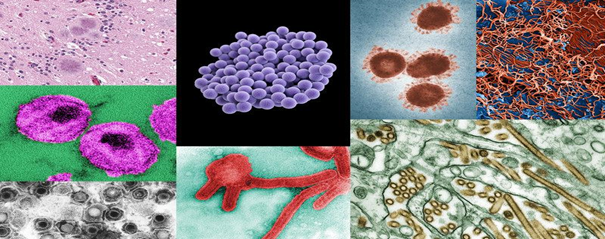

Microorganisms are these tiny fascinating living organisms that can’t be seen through the naked eyes as they are sized in microns. But these can go to places unimaginable and have the potential to even kill such comparatively giant living beings like us, humans. They are broadly categorized as Bacteria, Fungi & viruses and not all of them are dangerous to the Homo sapiens. However, this article only focuses on the harmful ones which can cause deadly diseases, and the term deadly here, refers to the fatality rate of that disease (number of deaths per number of cases) and the number of deaths in total caused by a disease.
Below mentioned are some of the deadliest diseases that the world has encountered to date and is still recovering from as they have caused outbreaks, epidemics, and even pandemics spreading from continent to continent.
The Plague

An infection caused by Yersinia pestis can take up any form- Bubonic, septicemic, or pneumonic. Historically speaking, the plague is considered to be one of the deadliest diseases as it killed off roughly 25 million Europeans in the 1300s and is still endemic to the western US. Out of the three, bubonic
Plague is considered to be the most common type and is characterized by swelling of the lymph nodes. Humans usually get this disease after being bitten by a rodent flea that is carrying the plague bacterium, or by handling an infected animal. However, this disease can be kept in check with antibiotics on board and carrying out an early diagnosis of the pathogen. Culturing the infected sputum /blood samples on a culture media that supports the growth of Yersinia pestis can help in presumptive identification of the infection.
Antibiotic-resistant infections

Tuberculosis and MRSA (Methicillin-Resistant Staphylococcus aureus) infections are considered to be among the globe’s top killers when it comes to treatment failure as these infections result in hundreds of thousands of fatal cases every year only because of antibiotic resistance. Overuse and misuse of antibiotics help the bacteria to develop resistance to the treatment, thus intensifies the problem.
MRSA infections are basically staph infections caused by a strain of Staphylococcus aureus that has developed resistance to penicillin and penicillin-related antibiotics, including methicillin. These infections usually spread through physical contact and are mostly acquired during hospital stays. Medical devices contaminated with MRSA strains, when inserted into the human system, can lead to lethal infections by spreading through the bloodstream and infecting lungs & urinary tract. However, early diagnosis of this disease is possible with culturing a tissue sample or nasal secretions on a selective media that encourages the growth of MRSA strains.
Tuberculosis is a highly contagious disease of the lungs and is typically caused by Mycobacterium tuberculosis. It is characterized by fever, weight loss, night sweats, and persistent cough that may last for many months. In 2018, there were an estimated 10 (9.0—11.1) million new (incident) TB cases worldwide, of which 5.7 million were men, 3.2 million were women and 1.1 million were children. Though, with early detection and treatment, this disease can be possibly cured. The rapid TB diagnostic kits, as the name suggests, helps in the rapid detection of the pathogen from a suspected sputum sample and also aids in determining the sensitivity pattern of the bacteria leading to a better cure.
Sexually transmitted diseases
Diseases spreading through sexual contact or through sharing needles/ syringes are also considered to be deadly to the human species as with each year, the cases of syphilis, gonorrhea, and chlamydia start increasing in number. These STDs if left untreated can lead to infertility and ectopic pregnancies.
Chlamydia is considered the second most prevalent STD in the US after AIDS. Its cases have skyrocketed with over 1.7 million cases in 2017. The disease is caused by a gram negative diplococcus, Neisseria gonorrhea which results in an infection of the fallopian tube/ uterus in women and epididymis infection in men. The major drawback in the early detection of the disease is that the infection mainly remains symptom-free. The suspected samples (endocervical mucus specimens) however are primarily plated on thayer martin agar for isolating Neisseria spp. during the laboratory diagnosis.
Syphilis infection caused by Treponema pallidum subspecies pallidum is also harmful to humans and is characterized by reddish-brown sores, fever, and swollen glands, etc. Congenital syphilis that infects newborns has become a major concern for the world as the death cases have increased from 77 to 94, approx. 22 percent from 2017 to 2018. A similar case was observed for chlamydia which reached an all-time high record.
Pneumonia
With the tagline of the world’s leading killer of children, this infection remains among the top deadly diseases to be caused by a bacterium, a virus, or a combination of both. It involves inflammation of the lungs and is characterized by filling up of the air sacs, or alveoli with fluid or pus. Various bacteria like Burkholderia cepacia, Klebsiella pneumonia, Streptococcus pneumonia, and sometimes Pseudomonas aeruginosa causes Pneumonia. The diagnostic test of pneumonia includes blood tests and sputum tests which require culturing the suspected samples onto specific culture media for isolating and cultivating the pathogenic strains.
Cholera

Cholera is an intestinal infection caused by the bacterium- Vibrio cholerae. This disease has the potential to kill people in hours if left untreated and is often characterized by watery diarrhea and severe dehydration. Around the world, approximately 1.3 to 4 million cases are recorded every year with approximately 100,00 deaths occurring each year. The causative agent, V.cholerae is a natural inhabitant of the saltwater and spreads in the environment through contaminated water sources. The high salinity tolerance capacity of the bacteria makes it suitable to be recovered in the selective media- TCBS agar which remains the standard culture media for culturing suspected stool specimens.
Measles
Measles, one of the most contagious of all infectious diseases, is caused by the rubeola virus and is the most significant cause of death among the kids who remain unvaccinated. In 2018, almost 10 million people caught the viral infection with Madagascar, Ukraine, The Democratic Republic of the Congo, and the USA being the hard-hitting countries around the world. The disease is diagnosed by collecting the throat (nasopharyngeal) swabs in a viral transport kit and serum samples for detecting IgM antibodies.
With new diseases being evolved each year, it has become important for scientists to develop new methods for diagnosing or treating fatal cases.
Please visit us our Products Page – https://www.tmmedia.in/products/

Maintaining the highest standards of quality and safety is paramount in pharmaceutical manufacturing. Strict adherence to current good manufacturing practices...
Read More
Potato Dextrose Agar (PDA) is a widely utilized medium in microbiology, specifically designed for the isolation and enumeration of yeasts...
Read More
In the complicated world of microbiology, where precision and reliability are of utmost importance, Soybean Casein Digest Agar (SCDA) stands...
Read More
Have you ever wondered how scientists can grow entire plants from just a few cells in a laboratory? The answer...
Read More
In the world of pathogenic identification, one crucial player in the isolation and cultivation of Vibrio species is Thiosulfate-citrate-bile salts-sucrose...
Read MoreMicrobiology, as a scientific discipline, relies heavily on precise tools and methodologies for understanding the details of the microbial world....
Read More